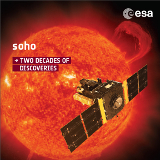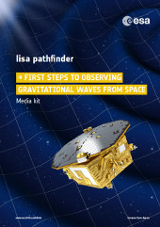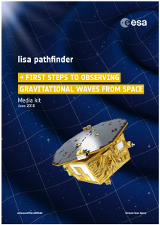ESA Science & Technology - Publication Archive
Publication archive
Publication archive
During a search for coherent signals in the X-ray archival data of XMM-Newton, we discovered a modulation at 1.2 s in 3XMM J004301.4+413017 (3X J0043), a source lying in the direction of an external arm of M 31. This short period indicates a neutron star (NS). Between 2000 and 2013, the position of 3X J0043 was imaged by public XMM–Newton observations 35 times. The analysis of these data allowed us to detect an orbital modulation at 1.27 d and study the long-term properties of the source. The emission of the pulsar was rather hard (most spectra are described by a power law with Γ < 1) and, assuming the distance to M 31, the 0.3–10 keV luminosity was variable, from ~3 × 1037 to 2 × 1038 erg s-1. The analysis of optical data shows that, while 3X J0043 is likely associated to a globular cluster in M 31, a counterpart with V ≳ 22 outside the cluster cannot be excluded. Considering our findings, there are two main viable scenarios for 3X J0043: a peculiar low-mass X-ray binary, similar to 4U 1822−37 or 4U 1626−67, or an intermediate-mass X-ray binary resembling Her X−1. Regardless of the exact nature of the system, 3X J0043 is the first accreting NS in M 31 in which the spin period has been detected.
From August to November 2014 the Rosetta orbiter has performed an extensive observation campaign aimed at the characterization of 67P/CG nucleus properties and to the selection of the Philae landing site. The campaign led to the production of a global map of the illuminated portion of 67P/CG nucleus. During this prelanding phase the comet's heliocentric distance decreased from 3.62 to 2.93 AU while Rosetta was orbiting around the nucleus at distances between 100 to 10 km. VIRTIS-M, the Visible and InfraRed Thermal Imaging Spectrometer – Mapping channel (Coradini et al., [2007] Space Sci. Rev., 128, 529–559) onboard the orbiter, has acquired 0.25–5.1 µm hyperspectral data of the entire illuminated surface, e.g. the north hemisphere and the equatorial regions, with spatial resolution between 2.5 and 25 m/pixel. I/F spectra have been corrected for thermal emission removal in the 3.5–5.1 µm range and for surface's photometric response. The resulting reflectance spectra have been used to compute several Cometary Spectral Indicators (CSI): single scattering albedo at 0.55 µm, 0.5–0.8 µm and 1.0–2.5 µm spectral slopes, 3.2 µm organic material and 2.0 µm water ice band parameters (center, depth) with the aim to map their spatial distribution on the surface and to study their temporal variability as the nucleus moved towards the Sun. Indeed, throughout the investigated period, the nucleus surface shows a significant increase of the single scattering albedo along with a decrease of the 0.5–0.8 and 1.0–2.5 µm spectral slopes, indicating a flattening of the reflectance. We attribute the origin of this effect to the partial removal of the dust layer caused by the increased contribution of water sublimation to the gaseous activity as comet crossed the frost-line.
--- Remainder of abstract truncated due to character limitations ---
Aims. These signatures match the appearance of a diamagnetic cavity as was observed at comet 1P/Halley in 1986. The cavity here is more extended than previously predicted by models and features unusual magnetic field configurations, which need to be explained.
Methods. The onboard magnetometer data were analyzed in detail and used to estimate the outgassing rate. A minimum variance analysis was used to determine boundary normals.
Results. Our analysis of the data acquired by the Rosetta Plasma Consortium instrumentation confirms the existence of a diamagnetic cavity. The size is larger than predicted by simulations, however. One possible explanation are instabilities that are propagating along the cavity boundary and possibly a low magnetic pressure in the solar wind. This conclusion is supported by a change in sign of the Sun-pointing component of the magnetic field. Evidence also indicates that the cavity boundary is moving with variable velocities ranging from 230 − 500 m/s.
Published online 11 February 2016
Context. Dust jets (i.e., fuzzy collimated streams of cometary material arising from the nucleus) have been observed in situ on all comets since the Giotto mission flew by comet 1P/Halley in 1986, and yet their formation mechanism remains unknown. Several solutions have been proposed involving either specific properties of the active areas or the local topography to create and focus the gas and dust flows. While the nucleus morphology seems to be responsible for the larger features, high resolution imagery has shown that broad streams are composed of many smaller jets (a few meters wide) that connect directly to the nucleus surface.
Aims. We monitored these jets at high resolution and over several months to understand what the physical processes are that drive their formation and how this affects the surface.
Methods. Using many images of the same areas with different viewing angles, we performed a 3-dimensional reconstruction of collimated jets and linked them precisely to their sources on the nucleus.
Results. We show here observational evidence that the northern hemisphere jets of comet 67P/Churyumov-Gerasimenko arise from areas with sharp topographic changes and describe the physical processes involved. We propose a model in which active cliffs are the main source of jet-like features and therefore of the regions eroding the fastest on comets. We suggest that this is a common mechanism taking place on all comets.
Aims. We investigate whether quasars can be used to independently verify the parallax zero-point in early data reductions. This is not trivially possible as the observation interval is too short to disentangle parallax and proper motion for the quasar subset.
Methods. We repeat TGAS simulations but additionally include simulated Gaia observations of quasars from ground-based surveys. All observations are simulated with basic angle variations. To obtain a full astrometric solution for the quasars in TGAS we explore the use of prior information for their proper motions.
Results. It is possible to determine the parallax zero-point for the quasars with a few μas uncertainty, and it agrees to a similar precision with the zero-point for the Tycho-2 stars. The proposed strategy is robust even for quasars exhibiting significant spurious proper motion due to a variable source structure, or when the quasar subset is contaminated with stars misidentified as quasars.
Conclusions. Using prior information about quasar proper motions we could provide an independent verification of the parallax zero-point in early solutions based on less than one year of Gaia data.
This document presents the proposed activities to be initiated in 2016 in the Exploration Technology Programme (ETP, funded by MREP-2). It also summaries the current state of MREP-2 Programme's technology programme as a whole, providing an overview of all running and proposed Technology Development Activities supporting the implementation of the Programme.
This document is provided for information only and is subject to future updates.
Version issued December 2015: Download document (pdf, 2.9 MB)
This media kit contains background information of use to journalists and reporters covering the LISA Pathfinder mission.
Topics covered:
Why LISA Pathfinder?
Mission at a glance
A challenging build
What LISA Pathfinder is doing and how
Paving the way for gravitational-wave observatories in space
100 years of general relativity
LISA Pathfinder in the context of great physics experiments
Updated in June 2016 to reflect the detection of gravitational waves by the Laser Interferometer Gravitational-Wave Observatory (LIGO) and to account for operational milestones of LISA Pathfinder.



